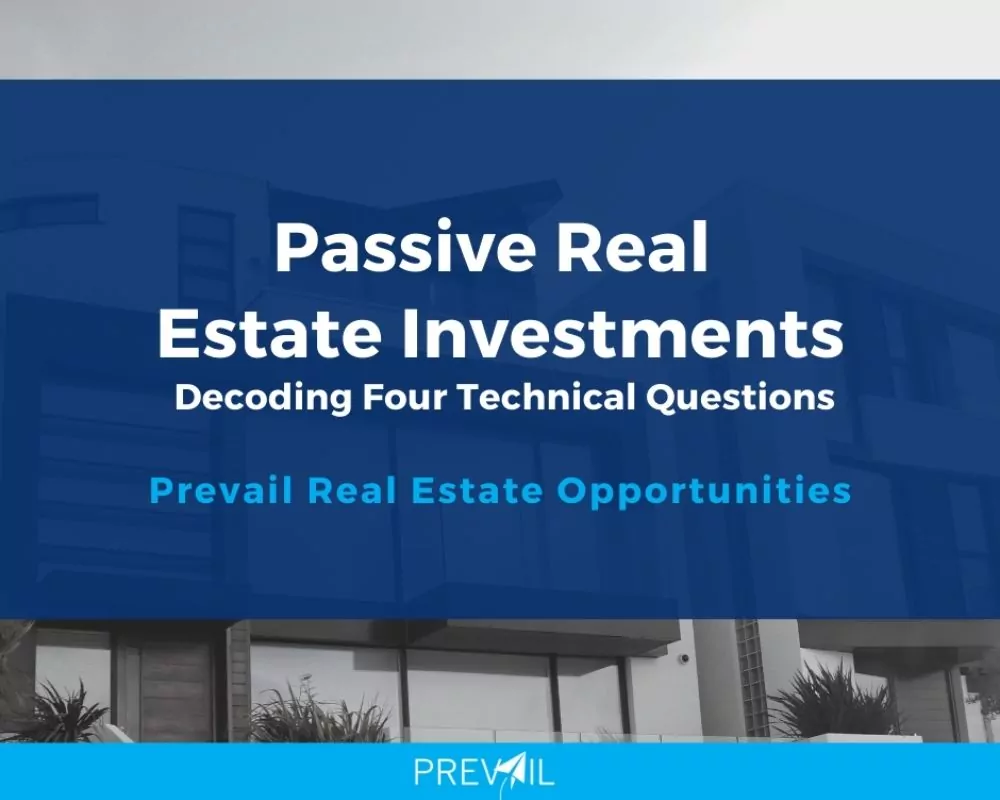Passive Real Estate Investments – Decoding Four Technical Questions
Whether you have a background in real estate investing or are a newbie, there are a handful of technical things you need to know about passive investments that work a little bit differently than other kinds of investments.
Grandpa had a couple of rentals? Great.
Dad flipped homes for profit? Cool.
Now you are looking at approaching real estate a little differently? Perfect.
It is natural to ask what is the same or different about returns, minimum investment requirements, taxes, and more when you do it on a passive basis. We are going to unpack four common technical issues that you should be aware of.
• Returns. So, the point of an investment is to make a return, not lose money, right? By investing passively in real estate, you can earn two types of returns. First, cash flow returns are checks, direct deposits (or ACH’s) typically made monthly or quarterly from the time the deal closes until the asset is sold. Second, profit split returns are where the investors split the profit from the sale of the property according to the rules outlined in the subscription agreement and placement memorandum.
Let’s say you invest $100K and are expecting a potential 8-10% in cash flow returns which translates to about $8K per year or around $667 per month.
Then, when the property is sold (maybe 5 years later), you could expect up to 40-60% additional returns on your initial $100K. That means you get your initial $100K back plus around $50K in profit split returns.
That all tracking?
$8K of cash flow returns per year plus $50K in profit at the sale means you would turn your $100K into a total of $200K in about 5 years.
Of course, this all comes with the caveat that these are estimated (or pro forma’d) returns that will vary based on market conditions, location, deal structure, and many, many more variables. No way is it guaranteed you will double your money. But that is the plan.
• Minimum investment amount. The typical minimum threshold for investing passively is $50K. Anyone interested in investing this much should have much more in liquid assets available, should be aware of the potential for losses, and be “ok” if they should lose it.
While invested, your money is illiquid (you can’t get it back until the property is sold), so you need to make financial arrangements to ensure you have access to plenty of cash while the investment is locked up.
• Retirement funds (Yes or No). Retirement funds (401k, IRA, etc.) can be used for passive real estate investments this is how many people experiment with the process.
To use retirement funds, you first have to roll your retirement account into a self-directed IRA account. There are many self-directed IRA companies out there who would be happy to help you with this. Once your funds are in the self-directed IRA, you can choose where you want to invest.
You will need to closely coordinate with your self-directed IRA custodian, provide them with copies of the legal documents for the transaction, and they will send the funds out on your behalf.
One caveat here. All returns from the deal MUST go directly back into the self-directed IRA account and never into your account.
• Tax Benefits. Unfortunately, Uncle Sam has something to say about every investment that you make, and passive real estate investing is no different. Here, you are a part-owner in the underlying property which means you get to share in the tax benefits. One of the largest benefits is accelerated depreciation through cost segregation.
When you own rental property, you can depreciate the value over time. With commercial real estate, the sponsors often order a cost segregation study where an expert determines which assets can be depreciated more quickly than others.
Fancy words for sure, but the effect is to front-load depreciation into the first years of ownership instead of over 30 years – a good deal for a 5 year hold period. What this means is that your share of the depreciation can help offset your share of the cash distributions received, lowering the taxes you pay every year.
Wrapping up the technical details.
Now that we’ve walked you through a few of the more common technical questions about passive investments in real estate, you can evaluate deals confidently.
You know that retirement funds can be used, typical minimum investments are $50K and there’s potential for both solid returns and serious tax benefits. With everything there are risks, but you now have a clearer picture of the next steps.
If you are thinking about using retirement funds to invest, you know that you need to get some help to roll your funds into a self-directed IRA. If you aren’t sure if you had enough cash to invest, now you have a feel for the minimums. If you didn’t understand how you could double your money in a few years, now you know it is possible.
With fewer technical questions floating around, you’re that much closer to becoming a confident, passive real estate investor.

















